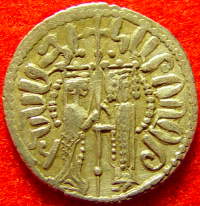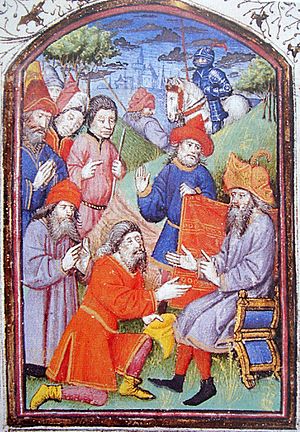Hethum I, King of Armenia facts for kids
Quick facts for kids Hethum IՀեթում Ա |
|
|---|---|

Hethum I with Queen Zabel on a coin
|
|
| King of the Armenian Kingdom of Cilicia | |
| Reign | 1226 – 1270 |
| Predecessor | Isabella |
| Successor | Leo II |
| Born | 1213 |
| Died | 21 October 1270 (aged 56–57) |
| Spouse | Isabella |
| Issue | Euphemia Maria Sybille Rita Leo II Thoros |
| Dynasty | House of Lambron |
| Father | Constantine of Baberon |
| Mother | Princess Alix Pahlavouni of Lampron |
Hethum I (born 1213, died October 21, 1270) was a powerful king. He ruled the Armenian Kingdom of Cilicia from 1226 to 1270. This kingdom was also known as "Little Armenia." Hethum was the son of Constantine, Lord of Baberon. He started a royal family line called the Hetoumids.
Hethum was known for his smart choices in dealing with other powerful groups. He made a special trip to the Mongol Empire's court in Karakorum, Mongolia. This journey was written down by his friend, the historian Kirakos Gandzaketsi.
Contents
Becoming King
Hethum's father, Constantine, was an important leader. He was in charge while the young queen, Isabella, Queen of Armenia, was growing up. Isabella first married a prince named Philip. But Constantine arranged for Philip to be removed.
Instead, Constantine made Isabella marry his own son, Hethum. This happened on June 14, 1226. After their marriage, Isabella and Hethum ruled the kingdom together.
Hethum's Family
Hethum and Isabella had several children. Their children helped shape the future of the kingdom and its allies.
- Leo II (died 1289)
- Thoros (died 1266) – He was killed fighting the Mamluks. Thoros had one child named Melkum.
- Sibylla (died 1290) – She married Bohemond VI of Antioch.
- Euphemie (died 1309) – She married Julian Grenier, a lord from Sidon.
- Rita of Armenia – She married Constantine of Servantikar.
- Maria – She married Guy of Ibelin.
- Rouben
- Vasak
Armenia and the Mongols
Hethum was a key player in the politics of his time. The Armenian Kingdom of Cilicia had connections with many different groups, including the European Crusader states.
As the powerful Mongol Empire grew closer to Armenia, King Hethum made a big decision. He chose to become a loyal partner of the Mongols. This meant his kingdom would be protected by them.
Meeting the Mongols
In 1247, Hethum sent his brother, Sempad the Constable, to the Mongol court. Sempad met the Great Khan Güyük and made a formal agreement. This agreement made Cilician Armenia a "vassal state" of the Mongol Empire. This means Armenia agreed to support the Mongols and in return, they would be protected.
In 1254, Hethum himself traveled all the way to Mongolia. He wanted to make sure the agreement stayed strong. His journey was long, passing through many lands. He brought many gifts and met with Möngke Khan, another Mongol leader.
A Famous Journey
A member of Hethum's group, Kirakos Gandzaketsi, wrote about this amazing trip. His book was called "The Journey of Haithon, King of Little Armenia, To Mongolia and Back." This book is important because it describes Mongol, Buddhist, and Chinese cultures. It also talks about the geography and animals Hethum saw.
On his way back, Hethum also visited the Mongol leader Bayju. He even saw Bayju win a battle against the Seljuq Turks.
Alliances and Battles
Hethum encouraged other Christian rulers to join forces with the Mongols. Only his son-in-law, Bohemond VI of Antioch, followed his advice.
Armenian soldiers fought alongside the Mongol army. They helped capture Baghdad in 1258. Both Armenian and Antiochene forces also fought with the Mongols at the Siege of Aleppo and the Fall of Damascus in 1260. Some old stories say that Hethum, Bohemond, and the Mongol general Kitbuqa entered Damascus together in victory. However, modern historians are not sure if this story is true.
Despite these victories, the Mongols faced a strong enemy. In September 1260, the Egyptian Mamluks defeated the Mongols at the Battle of Ain Jalut. This pushed the Mongols back across the Euphrates River. The Mongols would not control Syria again for a long time.
Later Years and Retirement
In his final years, Hethum's kingdom faced many attacks. Because Hethum had supported the Mongols, the Mamluks invaded Armenia in 1266. The Armenian army was much smaller than the Mamluk army.
At the Battle of Mari, the Armenians suffered a terrible defeat. Hethum's son, Leo, was captured and put in prison. After this disaster, many Armenian cities were attacked. The capital city of Sis was burned. Thousands of Armenians were killed, and 40,000 were taken captive.
Hethum had to give up some land to the Egyptians to get his son Leo back. In 1268, the allied Principality of Antioch was also taken over by the Egyptians.
In 1270, Hethum decided to step down as king. He gave the throne to his son Leo. Hethum then spent the rest of his life as a monk in a monastery.
See also
 In Spanish: Haitón I de Armenia para niños
In Spanish: Haitón I de Armenia para niños


